What Is Crema? How to Make Crema ? Enjoy Crema with Coffee. Its Benefits, History, Uses and Recipes
by Selmir Omic
In recent times, the word "crema" has become one of the hottest buzzwords being discussed out there in the coffee world right now.
It has become an obsession for some coffee fanatics, because it has come to symbolize coffee quality.
Although crema seems to be something that the coffee world has come to focus on more recently, it has indeed been a part of coffee culture since the invention of espresso, over one hundred years ago.
Contents
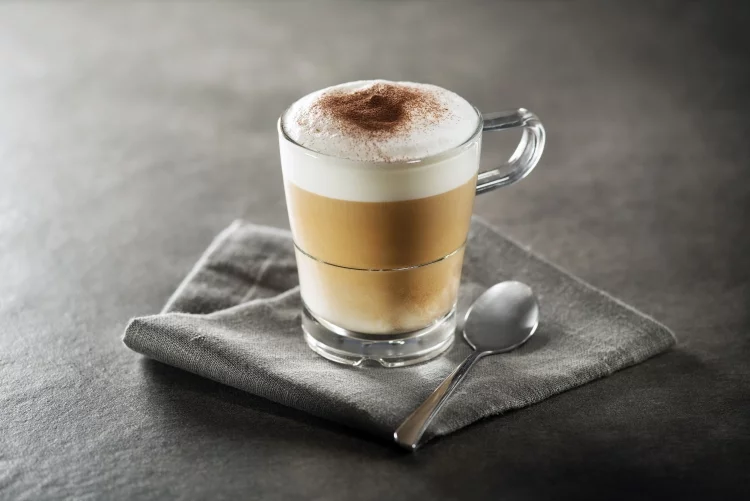
A Brief History Of The Word "Crema"
The first espresso coffee machine was invented by Angelo Moriondo in 1884, where he displayed his marvellous invention for the general expo of Turin.
Coming from a very entrepreneurial family, the idea for the espresso machine was sparked when the customers at his hotel began demanding a faster-produced coffee, due to their increasingly busy and hurried lives.
The diagram you see below was built by a mechanic named Martina, who worked closely with Moriondo, as the machine received its patent and was subsequently re-patented as Moriondo made great improvements over time.
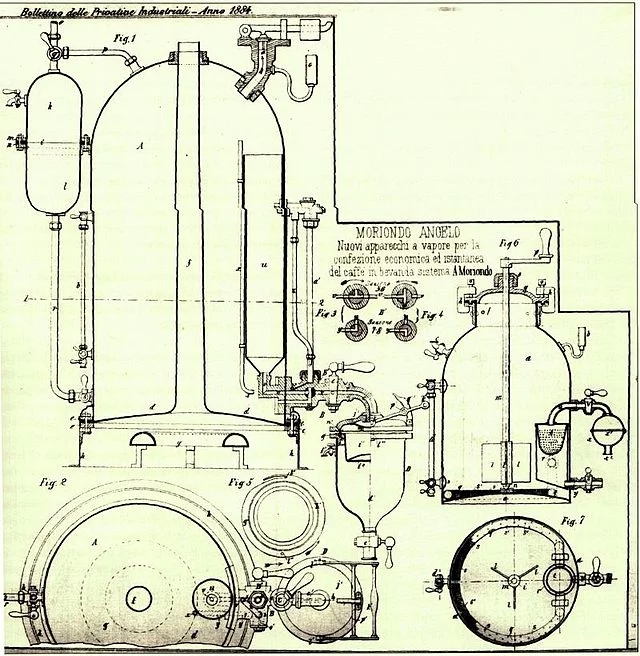
Unlike the espresso machines of today, this bulky specimen was not yet prepared to fulfill the "express" part of the word "espresso", and it was at first unable to deliver a hot, tasty beverage super-quick to an individual customer.
It wasn't until decades later that, in Italy, espresso bars and espresso consumption began to explode in popularly due to increased urbanization, and coffee making became more of a fine art.
Baristas with a high level of skill became highly prized, as they were able to dazzle customers not only with the exquisite taste of their coffee making, but also the style with which it was presented. A rich crema, as it became known, was part of this presentation.
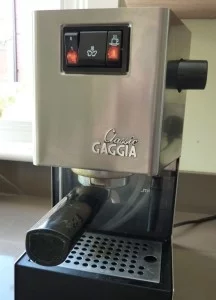
But it wasn't until the 1930s that the Italian coffee company Gaggia began to produce a new line of espresso machines with a revolutionary new technology to make high quality espresso faster and better than ever before. The idea for his new machine was inspired by Achille Gaggia observing pistons of an American army jeep in action.
*Read more about the Gaggia story over here at their website.
Due to the way in which they built their new espresso machines, Gaggia espresso makers became known for being able to produce rich and flavorful crema with their espressos "on demand", which added an enticing aroma to their already delicious drink. It was at this time that word about crema began to spread, as prior to this crema was a more incidental happenstance with espresso.
What Is Crema?
Simply put, it is the thin layer of cream-like foam at the top of a cup of espresso, formed during the process of an espresso extraction. This foam, or froth, when done right, is usually a red-golden color, and accompanies the espresso into the cup as the shot is pulled, and sits temporarily on the top.
Maybe some of you are having their cup of espresso without even noticing whether there is a crema on top of it or not, but for the professional baristas out there, it's sure to be a big consideration in their preparation of espresso.
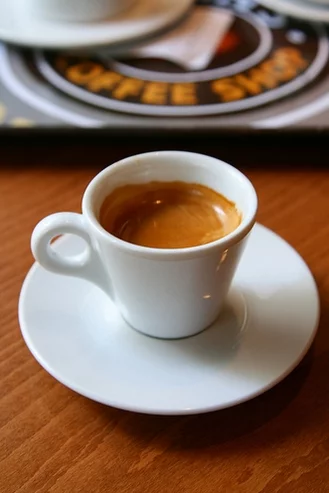
When serving espresso, a good barista can determine the quality of the espresso just by taking a close look at the crema that sits on the top.
To provide a slightly more technical definition, crema consists of gas bubbles suspended in a liquid film which has high "surface tension" between the water molecules.
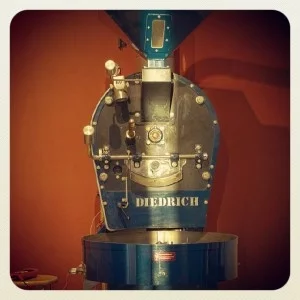
During the coffee roasting process, a lot of CO2, or carbon dioxide, is produced. Although a great deal of this CO2 is lost as the porous beans cool and rest, with most roasters taking a couple of days between the roasting and the grinding, once the grinding has started, there is also a significant quantity which retains in the cells.
As the hot water hits the ground coffee with high pressure in the espresso machine, the water emulsifies the otherwise insoluble oils in the coffee; suspending them in micro bubbles of air, and the water gets supersaturated with the CO2. The result is hundreds of tiny bubbles appearing as soon as the liquid is released from the porta-filter.
*Note to coffee geeks: to really get a good idea of what crema is all about scientifically, you may want to take a closer look at the emulsion process itself, via this link here.
So, crema is a kind of unstable emulsion formed from coffee bean oil and water being brought together through high pressure. Being unstable, it won't last too long. It is similar to the "head" on beer, in that it eventually goes away, but definitely serves a purpose when it comes to the smell and taste of, in this case, espresso.
The Benefits of Crema
Every day, people all around the world drink espresso and enjoy its delightful flavor. Yet often times they will miss out on one of the best parts: crema. Crema is a very important part of the espresso-making process; without it, your shot would not taste as good.
Some may wonder if this is just some myth that baristas like to spread around. However, there are many reasons you will enjoy your shots much more if you let crema form before drinking!
1. Crema Changes the Flavor of Espresso
Crema is the word used to describe the foam on top of espresso - which makes sense because it infuses the coffee with its own flavors and oils. The crema of a shot changes the flavor from the ground coffee, making it more pure and enjoyable. Without crema, many espresso drinkers will notice a very bitter taste in their shots - this is because most cafes brew straight into cups without allowing for crema to form.
2. Crema Covers Up Undesirable Flavors
If you have ever pulled a shot that smelled burnt, chances are the crema helped cover up this unpleasant odor to make for a better tasting drink. This is because many of our taste buds are located at the top of our mouths, so it only makes sense to brew espresso with crema.
3. Crema Adds More Caffeine to the Shot
More caffeine hits your mouth with crema, so you will get a much stronger buzz from drinking your espressos. This is because there is more of the coffee in contact with the saliva when it also contains crema. Thus, this provides more of an effect on you! Just imagine if all shots came with crema ; you could put away your red bull and coffee just one cup!
4. Crema Is Not Just Coffee-Flavored Air
Cafe workers sometimes complain about people who do not let crema form, because they feel like their hard work goes to waste. People often say that crema is "just air" or "not real espresso." However, this is simply not true. Crema is made up of the oils and flavors that naturally occur in coffee. Thus, it can be considered part of your shot's flavor profile rather than just air that "came with it."
5. Crema Adds Extra Texture to Your Espresso
Many people consider crema to give their espressos an extra "texture" that they enjoy. Crema is not bitter, but has a sweeter flavor to it. Thus, it adds another dimension of taste that many coffee drinkers are very happy with!
6. Crema Adds Extra Flair to Your Drink
Many baristas and customers will tell you that espresso drinks just look better with a dollop of crema on top, and it is hard to disagree! This is because the presence of crema changes how your espresso looks; for example, if you were to pull a shot directly into an espresso cup, the color would be very dark. Yet if you allow it to form crema, then it will take on a much lighter and more vibrant color. Thus, it is not just about the taste; crema adds flair to your drink as well!
7. Crema Is More Than Just a Drink Additive
Many will say that "the proof is in the pudding," but the proof of crema is really all around you! Many people who do not let crema form will notice that their espressos do not taste as good. However, this is because allowing for crema to form gives you a much cleaner and better tasting shot of espresso!
The proof is in the pudding - or rather, the proof is in the crema. This tasty part of your shot changes its flavors, texture, and color. Thus, it should almost always be used in the espresso-making process!
With Crema, Its All About the Anticipation…!
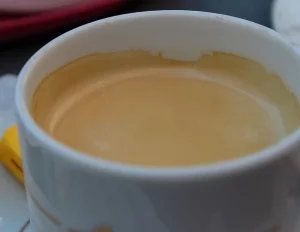
So now that we know (hopefully) what crema actually is in the definitive sense, lets talk about what the heck the point of this is for an espresso drinker.
For instance, does it have any flavor? What is it supposed to look or taste like? Well, opinions on this will obviously differ between different baristas, but here's our personal take on it.
In terms of the whole experience of having an excellent cup of espresso, crema is there to give your taste buds and your olfactory senses their first indication of the flavors locked into the espresso in your cup. Think of the crema as the first glimpse, or the unlocking of the subtle flavors inside your beverage.
Like fine beer, the crema perched precariously on top of your espresso, or the bubbles that make up the crema, act as messengers of true substance which is your espresso liquid.
To get slightly poetic for a second, you know when you see a sky first thing in the morning, and you can anticipate the type of day ahead - crema is like that sky! 🙂
However, by the same token, if the sky is looking a little bit red and angry in the morning, you may be in for some rough sailing ahead that day. Meaning, crema can just as easily tell you if your drink is going to be good or whether or not you should expect some sort of trouble.
So what makes for a good, or we might say healthy looking crema?
Have a watch of this video to see some healthy looking crema.
Like a lot of things, you can almost tell when the crema isn't looking so "healthy". Why? Because it won't be rich, amber-hued, and full of luscious little swirls. There are definitely some signs which can indicate a problem with our espresso.
Lets quickly run through some of these telltale signs of unhealthy crema…
1. Too light = not good.
2. Too gritty = not good.
3. Too many large bubbles = not good.
4. Disappears too quickly (under 1 minute) = not good.
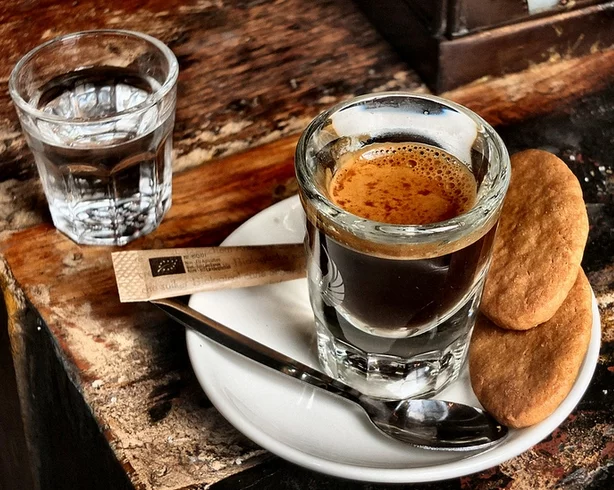
So the crema can show us as to whether the coffee is fresh (or not so fresh), and how fully the coffee was extracted. However, although it does count for much of the allure of a great cup of espresso, and it does give us a good indication of whether our espresso shot was a success or not, there is something we should mention, which is to say that crema isn't always an indicator of the espresso's quality.
Crema Isn't The Be All End All
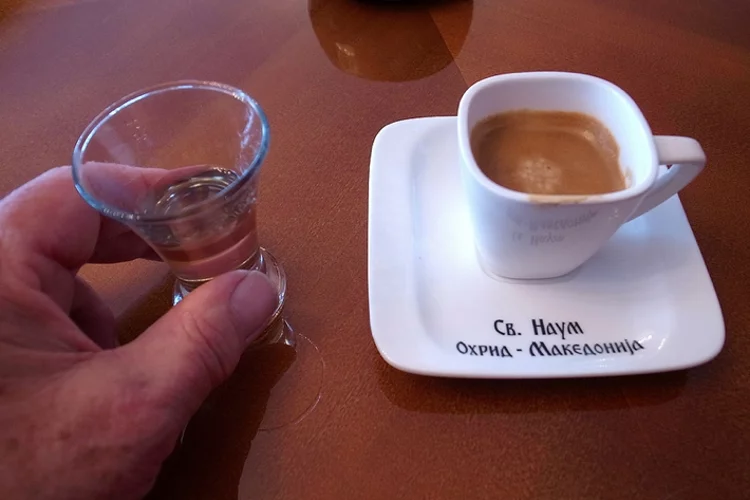
The twist here is that you can actually have espresso with very little crema or none at all that tastes amazing as well, and it all depends on the way the beans were processed at the plantations, and on how darkly they were roasted.
On the other hand, you can have low grade beans that manage to produce a good-looking crema, but they still may be bitter or unsavory to taste.
So, on the surface (literally), the crema might look great, but the espresso could still not be of high quality. But all of this points to a broader conversation about the how beans are prepared, of which crema is simply one aspect of this huge topic. The bottom line is that if the crema looks good, the espresso will be most likely good, though there can be exceptions.
How To Get Great Crema
Crema is the foam on top of your coffee, which certainly looks great but also serves some other purposes. You need a few things to possibly achieve a good and tasty crema with your espresso. You need a great coffee grinder, preferably one with conical burrs. You need a great espresso machine, of course. And you need great-tasting, healthy water.
The components of crema are basically an emulsion between water and oils (and some other things). The three main components of oil are fatty acids, glycerol esters and waxes. Coffee beans contain triglycerides, free fatty acids, and waxes.
Coffee oils can't be beaten by water because of their hydrophobic nature. The resulting emulsion produces the crema that we know and drink. [4]
Crema also has some other functions: it protects the coffee from oxidation, it acts as a seal against water and to some degree it contributes to the final taste of coffee. [5]
To create crema you need an espresso machine, ground coffee beans (preferably even) and hot water at 87-93 °C (189-200 °F). For best results, cold brewed coffee is preferred. [6]
What you need
An espresso machine A tamper with even pressure Coffee beans (preferably pre-ground) Hot water at 87-93 °C (189-200°F) An inquisitive mind!
Steps to create crema in your coffee:
1. Grind your coffee beans (to the right consistency)
2. Place ground coffee into your portafilter and place it on top of your machine's group head
3. Tamp down with even pressure, until you feel resistance
4. Slowly add hot water by either running it through an internal spout or externally using a steam wand between 45-55 lbs. of pressure [7] [8]
5. Wait for 30 seconds to let your coffee bloom and expand, so all the flavors locked in will be released at once!
6. It should have a golden brownish color, don't worry if it's lighter or darker than that
7. Enjoy!
The crema might not be too visible at first sight, but trust me it's there! The color is most often golden brown.
The Best Ways to Enjoy Crema in Your Coffee
Coffee oftentimes has a crema. Before we discuss the various ways to enjoy your coffee, let us first become familiar with what crema is and why it exists.
Crema is a creamy layer of dense foam at the top of your coffee cup after you prepare it using hot water. Though many people refer to this as "foam," this term is incorrect. Crema, in fact, has no actual bubbles; instead, it consists of oxidized (i.e., the coffee beans were roasted) coffee particles suspended within an emulsion of oils originating from lecithin present in the coffee bean. It also contains aromatics and heavier chemical compounds that contribute to its flavor, such as melanoidins (these are the chemical compounds that give beer their dark color and roasty flavor).
Crema is produced by a combination of pressure and high temperature. The high-pressure brewing method, which requires barista skills to create an optimal result, yields more crema than other common brewing methods like drip and French press.
The presence of crema affects the taste and aroma of coffee. The crema is responsible for sealing in and amplifying the delicate aromas of your coffee, which you will be able to smell once you put down your cup after taking a sip. This forms part of what we call "the sense of taste."
The color, viscosity, and thickness of the crema are directly related to the ratio of coffee solids dissolved in water. If your coffee has more solids or less water, you will experience a denser crema. The color is also affected by the temperature at which it was formed.
Now that we have familiarized ourselves with crema, let us now touch upon the various ways you can enjoy it!
Brewed coffee.
When you simply brew a cup of coffee and drink it black, crema will serve as your cream and sugar. You can then taste all three elements together in every sip: the bitterness from the coffee, the sweetness from the crema, and the smoothness from the milk.
Latte or cappuccino
Prepare your coffee as usual, but with more water than normal if you are planning to make a latte instead of an espresso drink. You can then mix in some steamed milk, pour it into a glass filled with ice if the weather is hot outside, and top it with extra crema.
Espresso.
A straight espresso can be enjoyed without any additions by adding just a touch of crema at the top. It is important to note that this should not be accompanied by much steamed milk, as it will dilute the taste of your espresso shot. If you want more than just an espresso, add some steamed milk into your cup to make yourself a cappuccino.
Conclusion for Crema Coffee Lovers
Crema is an important factor in the taste and texture of espresso. It is a layer of foam that sits on top of coffee drinks made with espresso machines. Crema is composed of tiny bubbles that are created when pressurized hot water passes through finely ground coffee beans. The crema traps aromas and flavors from the coffee, which are released as you drink it.
Crema also has nutritional value. It contains antioxidants, along with some vitamins and minerals. Crema can add a creamy consistency to your espresso drink and make it more pleasant to consume.
There are several factors that affect the quality of crema: the type of coffee bean, the grind size, the brewing temperature, and how long the coffee is brewed for. You can
Learn about the history of coffee, enjoy its various aromas and flavors, and have fun making variations to enhance the taste of your coffee! We hope you enjoyed learning about the ways to appreciate crema in your coffee!
Related Posts
 |
 |
 |
 |

About Selmir Omic
Selmir Omic is KYG's cannabis lifestyle writer. He currently resides in San Francisco and can often be found enjoying design-forward cannabis accessories, candles and seltzer simultaneously. When he's not writing about pot or waxing poetic about vape pens, Selmir can be counted on to offer sage advice about the best strains for anxiety or how to make cannabutter without a stovetop.
Thoughts on "What Is Crema? How to Make Crema ? Enjoy Crema with Coffee. Its Benefits, History, Uses and Recipes"
 |
 |
 |
 |
Get FREE Coffee Gifts now. Or latest free grinders from our best collections.
Disable Ad block to get all the secrets. Once done, hit any button below
 |
 |
 |
 |